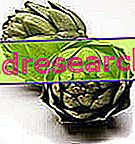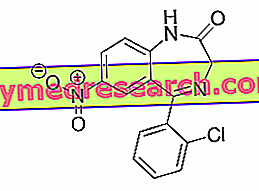Cynara scolymus L. = C. cardunculus var . scolymus
Fam. Asteraceae (Compositae)
Sottofam. Tubuliflorae
Description
The artichoke is a biennial herbaceous plant probably derived from the horticultural selection of wild thistle. Therefore it is not found in the spontaneous state, but is abundantly cultivated as a vegetable.
In the first year a rosette of very elongated and deeply divided basal leaves develops; in the second, from the center of the rosette develops the single floral stem with smaller sessile leaves and at the top the large heads with flowers all hermaphroditic tubuloses, with 5 blue-violet petals. The basal leaves of the artichoke are pinnate-lots 30-60 cm long and 5-10 cm wide, with a prominent central rib and toothed segments without thorns; those at the top of the caule are instead smaller, pinnate, lobed or almost whole. The fully developed leaf is green and hairless on the upper side, while the lower is lighter also due to the presence of long and very fine hairs.
Fruit: an achene supplied with pappus.
The smell of the artichoke is null and the taste is bitter.

Areal
According to some it would be a single species with two subspecies: C.scolymus, the artichoke, and C. cardunculus, the thistle. According to others, both are derived from wild thistle, widespread in Mediterranean Europe and northern Africa, developing the flower heads, in the artichoke, the petioles and leaves in the thistle. Already known to the Egyptians, the artichoke was consumed not only as a vegetable, but, in the Middle Ages, above all for the medicinal properties of the plant residing, rather than in the heads, in the leaves and stems of bitter taste, useful in liver disorders.
Culture
The artichoke wants a temperate and not humid climate, a deep soil rich in organic substance. Reproduction is done by seeds or, preferably by suckers (carducci), choosing those that have some woody root and 3-5 leaves. The carducci are planted in holes about 30 cm at a distance of 1m from each other. In the hole, above the fertilizer, the sucker is planted at a depth of 10 cm, then it is covered and bathed repeatedly. In summer all the flower-missing stems are cut close to the ground and in autumn all the suckers except 1-2, the most beautiful, around which the leaves are tied to preserve them from the cold. In May the inflorescences that are harvested begin to mature. An artichoke lasts 2-3 years.
The thistle, used for the leaves, undergoes a bleaching at the end of September-October, consisting in tying the leaves into bundles and then covering them with straw, well covering the foot well. This technique lasts 20-25 days, but can also last until December. Plants removed from the soil should be consumed immediately.
As a vegetable, the young artichokes are consumed before the anthesis, when they are covered by various layers of fleshy involucral bracts at the base and spinescent at the apex.
The active principles belong to various classes of substances:
1) caffeoilchinini compounds (eg cynarin) 2) sesquiterpene lactones, of the guaianolidic type, with a bitter taste (eg cinaropicrina) 3) flavonoidic derivatives 4) organic acids (glyceric, citric, lactic) 5) tannins, 6) organic salts potassium and magnesium, 7) anthraquinone glycosides 8) B vitamins and beta-carotene. 9) inulin. Therapeutic activity depends on the set of substances (synergy)
uses
In the food field, artichokes are consumed as vegetables.
In the pharmacy and herbal medicine the artichoke is used as a choleretic, hepatoprotective and diuretic. In pesticides the leaves are mainly used. Due to the presence of ortho-diphenols and sequiterpene lactones, this plant is counted among the bitters, with eupeptic and stomachic functions. It is also hypocholesterolizing.
The artichoke owes its choleretic action mainly to the presence of cynarin, a bitter and aromatic substance that stimulates the secretion of bile.
Watch the video
X Watch the video on youtubeIn cosmetics, the artichoke is used as a skin stimulant for scalp care.
SEE ALSO: ARTICHOKE nutrition tables
Milk thistle



